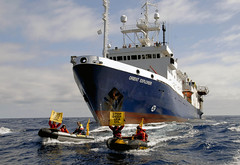 在人類從事各樣吵雜的海洋活動,打擾海洋生物平靜生活的數十年之後,聯合國主持的一項會議,啟動了長達十年的調查來研究這個問題。
在人類從事各樣吵雜的海洋活動,打擾海洋生物平靜生活的數十年之後,聯合國主持的一項會議,啟動了長達十年的調查來研究這個問題。
「就像人類依賴視覺,許多海洋生物則是以聲音作為由環境取得資訊的主要方法,」聯合國教科文組織(UNESCO)在研究中說。這項會議將在8月30日至9月1日於教科文組織位於巴黎的總部所舉行。
教科文組織表示,海洋科學家、私人企業代表以及軍事部門會在這次會議中,規劃十年期的「國際安靜海洋計畫」,進行實驗以更「明智且有效」的填補海洋噪音管理的空白。
教科文組織發表新研究報告時,做出聲明指出,「雖然少有研究證明之間的關聯,但學者們越來越懷疑,隨著噪音增加,特別是某些聲音,會改變海洋動物的行為,使他們正常的行為受到影響,例如尋找食物、配偶或是躲避掠食者。」
噪音不會侷限在一個海洋的某個範圍,因此造成的影響範圍是非常大的,海洋中各角落的生物都會受到衝擊。
在2008年12月,國際動物福利基金會(IFAW)在其發表的報告《海洋噪音:請關小聲點》中指出,藍鯨溝通的距離,因為噪音的增加而減少了90%。
 報告中計算,太平洋的船舶噪音在過去40年間,每十年就增加一倍,而全球航運量預計到2025年會再增加一倍,上次倍增的期間是1965年至2003年間。
報告中計算,太平洋的船舶噪音在過去40年間,每十年就增加一倍,而全球航運量預計到2025年會再增加一倍,上次倍增的期間是1965年至2003年間。
用於地震調查的空氣槍,在進行海底鑽油或是天然氣探測時產生的噪音峰值可達259分貝。
根據IFAW的報告,全球有90艘地震調查船,每一天都有四分之一數量的船隻在運作。
此外,全球估計有超過300套海軍聲納系統,能夠產生超過235分貝的聲壓。發出一次這樣的聲響產生的音量,是人類安全極限145分貝的十億倍以上。
科學家已發現,高強度聲納與鯨魚和海豚致命擱淺有關。在80年代中後期,一些大規模的擱淺被認為與海軍在加那利群島(Canary Islands)的活動有關。在之後的1992至1998年間,28頭熱氏中喙鯨(Gervais' beaked whales)擱淺在美國東岸的佛羅里達州和麻薩諸塞州之間,之後是北約在2002年9月進行低頻聲納測試後,更大規模的擱淺事件。
Mark Simmonds是鯨豚保育學會(WDCS)的科學主管,同時自1994年以後也是國際捕鯨委員會的成員,他說「儘管還有許多未知數,海洋中的噪音很明顯應該被視為對一般海洋生物,特別是鯨豚類的一種基本威脅。」「重要的是,這問題已受國內與國際公認,並且盡一切努力解決這個問題。」
With noisy human activity on the world's oceans disrupting the well-being of marine creatures, the United Nations is hosting a meeting to launch a decade-long investigation into the problem.
"Many marine species rely mainly on sound as a source of environmental information, in much the same way as human beings rely on their eyesight," the UN Educational, Scientific and Cultural Organization, UNESCO, said of the study. The launch meeting will be held at the agency's Paris headquarters from August 30 to September 1.
Marine scientists and representatives from the private sector and military establishments will use the meeting to plan the decade-long International Quiet Ocean Experiment aimed at filling the knowledge gaps so that management of ocean noise can be "more informed and effective," UNESCO said.
"Although very little research exists to prove any links, there is a growing suspicion that increasing noise levels, and some sounds in particular, are altering the behavior of marine animals and perhaps even reducing their capacity to perform normal life functions such as finding food, seeking out mates or avoiding predators," UNESCO said in a statement announcing the new research project.
Ocean noise cannot be contained within localized areas, so its impacts affect many aspects of marine life over vast areas of ocean.
In December 2008, the International Fund for Animal Welfare issued a report, "Ocean Noise: Turn It Down," showing that the distance over which blue whales can communicate is down by 90 percent as a result of intensified noise levels.
Ship noise in the Pacific Ocean has doubled every decade over the past 40 years and the global shipping fleet is expected to double in size by 2025, after doubling between 1965 and 2003, the report calculates.
Airguns used in seismic surveys to identify undersea locations likely to bear oil or gas generate sounds that peak at up to 259 decibels.
There are 90 seismic survey ships in the world, the IFAW report states, and a quarter of them are in use on any given day.
In addition, there are an estimated 300 naval sonar systems worldwide able to generate pressure sound waves of more than 235 decibels. Pings this loud are over one billion times more intense than the 145 decibel upper limit deemed safe for humans.
Scientists have linked high intensity sonar with fatal strandings of whales and dolphins. In the mid to late 1980s, several mass strandings were thought to be associated with naval activities around the Canary Islands. Later, between 1992 and 1998, 28 Gervais' beaked whales were stranded along the U.S. East Coast between Florida and Massachusetts, followed by more mass strandings in September 2002 after NATO tested low frequency sonar.
"Despite the many unknowns that remain, it is apparent that noise pollution in the seas should be regarded as a fundamental threat to marine wildlife in general and whales and dolphins in particular," said Mark Simmonds, WDCS director of science and a member of the Scientific Committee of the International Whaling Commission since 1994. "It is important that this is recognised at both national and international levels and that every effort be made to address it."
※ 全文及圖片詳見:ENS報導






